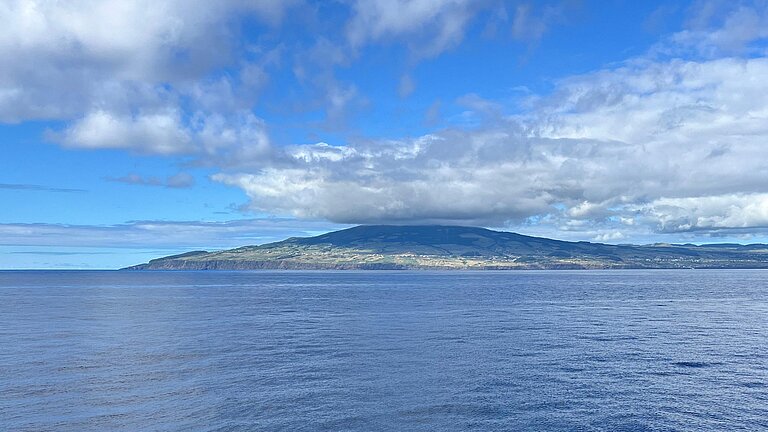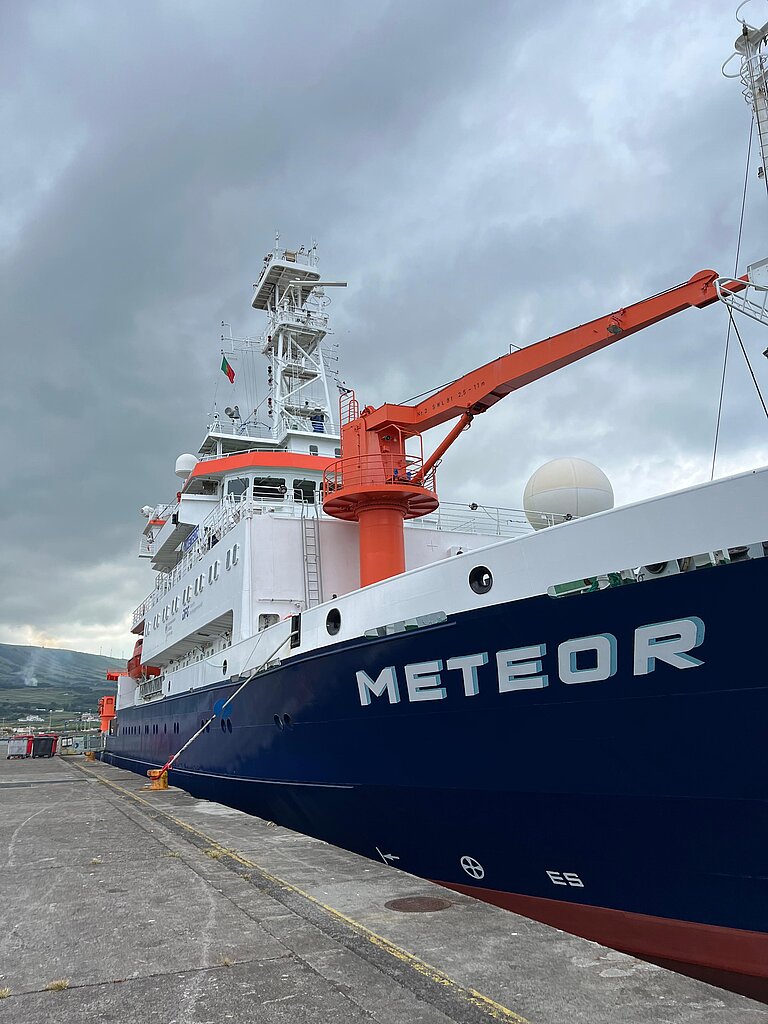Diving deeper for richer prey?
METEOR expedition M202 investigates the ecology of prey to better understand hunting behaviour of toothed whales in the Atlantic
Of all mammals, goose-beaked whales Ziphius cavirostris can dive the longest and deepest, and yet they are not one of the best-known whale species. They occur worldwide in temperate, subtropical and tropical latitudes, grow to around seven metres in length and their short beak actually resembles that of a goose. They prefer to feed on squid, which they hunt at depths down to 3000 metres, holding their breath for up to two hours.
“In order to better protect these animals, we need to know more about their foraging behaviour, their prey and their hunting habitats,” says marine biologist Dr Véronique Merten, who is a postdoctoral researcher in the deep-sea biology working group at GEOMAR Helmholtz Centre for Ocean Research Kiel. She leads the international expedition M202 with the German research vessel METEOR, which now set off for Terceira Island in the Azores archipelago. Under the title "Interactions between whales and cephalopods in the Atlantic Ocean" (ISAAC), the researchers want to investigate the prey diversity, characteristics, behaviour, abundance and distribution in the hunting zones of three co-occurring species of deep-diving toothed whales - the goose-beaked whale, the Sowerby's beaked whale Mesoplodon bidens and the Risso's dolphin Grampus griseus.
The exact interactions between these elusive deep diving whales and their hard-to-study cephalopod prey is the topic of a collaboration between an international team of scientists who each contribute their expertise on whales and whale prey. These research efforts are led by whale specialist Dr. Fleur Visser of the Royal Netherlands Institute for Sea Research (Koninklijk Nederlands Instituut voor Onderzoek der Zee, NIOZ) who runs a long-term research program on cetacean biology off the island off Terceira, and cephalopod and deep-sea biologist Dr. Henk-Jan Hoving (GEOMAR).
The programme of the M202 expedition includes extensive investigations at six deep-sea stations off the Azores island of Terceira. At the same time, the team of Dr. Fleur Visser executes shore and small boat operations to study the whales. The focus of M202 is less on the whales themselves and more on their potential prey. Dr Visser: “The three whale species hunt in different areas and at different depths. We want to find out which biological and oceanographic factors define their distinct hunting habitats." In the case of the goose-beaked whales, there is a concrete hypothesis: this species hunts furthest away from the island at depths between 900 metres and the seabed of around 1400 metres. “We think that this is where larger, adult, reproducing deep-sea squid occur. Larger, more calorific individuals could make the more energy-intensive hunting behaviour in deep depths worthwhile”.
To test this hypothesis the team strives to document deep-sea squid in their natural environment with deep-sea cameras and acoustic sensors to record species and biomass at specific depths. Cameras include the pelagic in-situ observation system PELAGIOS, will be towed by the ship and captures videos of the inhabitants of the open water. Echo sounders attached to PELAGIOS simultaneously determine the biomass in the water. The ocean floor observation system OFOS (Ocean Floor Observation System) will take videos and photos of the seabed. Nautilus Camera Systems with an optical lure will be drifting in the water column and deposited on the seafloor to attract and observe elusive deep-sea cephalopods. “A multitude of instruments is needed to document cephalopods, as many of them avoid oceanographic equipment” says Dr. Henk-Jan Hoving. To measure whale diving behaviour, communication and squid biomass beyond the cruise duration across a whole year, the team will recover and deploy a mooring with echosounders and hydrophones. The Nautilus Camera System and mooring work is led by the US American oceanographic institute Scripps Institution of Oceanography in La Jolla, California.
In order to track down potential prey such as cephalopods and fish without capturing or seeing them, the scientists will collect environmental DNA (eDNA) from water samples. The eDNA samples will be used for molecular analyses of genetic diversity of prey and population structure of toothed whales. Additionally, the team will use eDNA to compare prey communities off the Azores with other regions where goose-beaked whale populations occur. “The same whale species may exhibit different diving and hunting behaviours in different regions. We would like to know if prey communities also differ between these regions” says Dr. Merten.
"Whales play a key role in the deep-sea ecosystem. That's why it's so important to better understand their behaviour and the complex ecological relationships between them and their prey," says expedition leader Dr Merten. “In addition, our repeated efforts in the region over the recent six years has resulted in a unique inventory of cephalopod and fish species diversity in the waters off the Azores, which will help us to identify changes over time."
Expedition at a Glance:
METEOR Expedition M202
Project Name: Interactions between whales and cephalopods in the Atlantic Ocean (ISAAC)
Chief Scientist: Dr. Véronique Merten
Dates: 21.07.-07.08.2024
Departure: Praia De Vitoria (Portugal)
Arrival: Mindelo (Cabo Verde)
Study Area: North Atlantic

Various species of toothed whales live around the Azores island of Terceira and hunt at different depths. Photo: Véronique Merten, GEOMAR

Expedition M202, which has now set off from Terceira to investigate the connection between the toothed whales and their prey. Photo: Adobe Stock

For two and a half weeks, the researchers will be travelling with the METEOR in the North Atlantic to study the prey of toothed whales using state-of-the-art technology. Photo: Véronique Merten, GEOMAR


